by Winding Pathways | Jul 13, 2023 | Gazette Features, Travel/Columns
What is a Pilgrimage?
From: University of York: “‘Pilgrim’ and ‘pilgrimage’ are words that have carried a range of meanings over the centuries.
“The English term ‘pilgrim’ originally comes from the Latin word peregrinus (per, through + ager, field, country, land), which means a foreigner, a stranger, someone on a journey,…. It can describe a traveller making a brief journey to a particular place….”
Our Context
We consider travel a “pilgrimage.” The destination is not the sole purpose. We enrich our souls by being open to amazing travel surprises. Here are some we discovered on recent trips to New Jersey and Saskatchewan, Canada.
Interstate Highways are outstanding for getting places quickly, but we consider them a boring slog that bypasses fascinating places. Too many people focus on getting to a destination and miss intriguing sites along the way. In contrast, we often scan maps and brochures and, from time to time, duck off Interstates to drive on somewhat parallel, smaller roads stopping in towns bypassed by the interstates.
Two trips from this summer that highlight this concept come to mind. We’ve featured the Hopewell Earthworks around Chillicothe, OH, and took in great southern BBQ at Old Canal Smokehouse. The server presented us with an enormous slice of peanut butter pie and regaled us with tales of his childhood exploring the steep mounds and snaking earthworks while four of us made quick work of the dessert.
Easterly
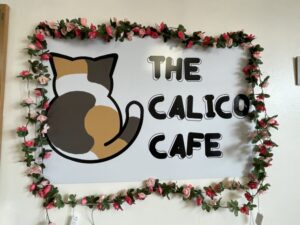
An unusual cafe.
On our return from the East Coast, we needed a respite from the truck traffic and fast driving of I-80, so we exited and drove through Brookville, PA. Seeking coffee, we discovered the Calico Cafe. While ordering we asked the barista where the restrooms were. She responded, “You’ll find them through the cat room behind me.” Cat room!!!!! Well, we opened the door to find people petting cats. It was a place for them to get their cat fix. We’re not cat people but the experience was different……something that can’t be found in chain eateries along Interstate exits. And the coffee was decent.
Westerly
On a more recent drive to Saskatchewan, Canada, we were cruising north on Interstate 29 in North Dakota and spotted a tiny note on the map showing the location of North America’s tallest structure. It was along a small paved road that headed in the direction we wanted to go, so we exited, made a few turns, and saw, not a massive skyscraper, but a 2063-foot-tall television tower. To stabilize the tower, guy wires extended scores of yards out. Not terribly exciting but a sight we’d have missed had we stayed on the interstate. And it has a history.
Just north of the tower we passed through the small town of Mayville, North Dakota, and discovered a gem of a college called Mayville State University. With 80+ majors/minors, a student/faculty ratio of 14:1, and reasonable tuition, MSU would be a good bet for a solid education and a bright, “no-debt” future. Only a few miles north we tented overnight in Turtle River State Park. Songbirds serenaded us in the evening and greeted us in the early morning.
Medicine Wheel and College Towns
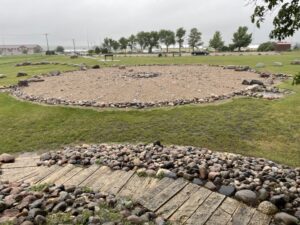
Glacial boulders align to the rising and setting sun and moon.
On our return trip we were eastbound on Interstate 94. We’d picked up a brochure at a North Dakota welcome station about the Medicine Wheel Park in Valley City, a town between Bismarck and Fargo. Even though it was raining we exited, donned raincoats, and walked around a fascinating and well-maintained medicine wheel almost adjacent to the big road. The structure, inspired by the Big Horn Medicine Wheel, marks the rises and sets of the sun and moon in relation to the Earth. Then we drove through Valley City State University before jumping back on the big road. VCSU has an interactive financial program with surrounding states and two Canadian provinces. Recreational opportunities abound.
Our western trip passed the geographic center of North America in Rugby, ND, (watch the video! It’s rather fun!), and a Continental Divide (Laurentian) between water flowing to Hudson Bay and that flowing to the Gulf of Mexico. Actually, a map reveals several watershed divides in the Americas.
Most travelers would have buzzed by these interesting stops. Curiosity grips us and leads us to unusual places we’d usually never heard of. We are richer for this.
Great Plains Colleges
Our son, Daniel, graduated from a college few people have ever heard of – Black Hills State University in Spearfish, South Dakota. It was an outstanding educational experience for him. And, tuition and living expenses were modest. He graduated debt free.
We’ve explored other colleges in small Great Plains towns, sometimes to have coffee in their student center, and to learn about them. Many, like Black Hills State, are little known, offer outstanding education, and are inexpensive. They offer students the chance to earn a college degree without debt.
Here are a few we’ve visited:
Black Hills State, Spearfish, South Dakota.
Valley City State University, Valley City, North Dakota
Mayville State University, Mayville, ND
Wayne State University, Wayne, Nebraska
Know someone considering college? One of these rather obscure but top-notch schools might be a perfect match……and there are many more we’ve yet to visit.
by Winding Pathways | Jul 6, 2023 | Nature, Trees, Trees/Shrubs
Just what impact did the heavy wildfire smoke that blanketed vast regions of Canada and the United States have on plants? We wondered. The news media warned of smoke’s impact on people and pets and cautioned us to stay indoors and limit physical activity. But what about plants?
For many June days smoke from Canadian fires settled over Winding Pathways and a vast area of North America. With the Western United States likely to ignite later in the summer, it’s time for Smokey Bear to get ready for more action these growing-season days.
-
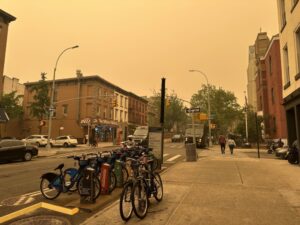
-
Air quality is compromised by smoke. Photo credit NP
Impact on Photovoltaics
We watched the real-time production monitor on our photovoltaic system during smokey days. It indicated that smoke was reducing our collector’s ability to turn solar energy into electricity. Was something similar happening with crops, trees, and lawns?
We turned to wildfire and smoke experts at our alma mater, the University of Idaho’s College of Natural Resources, for answers.
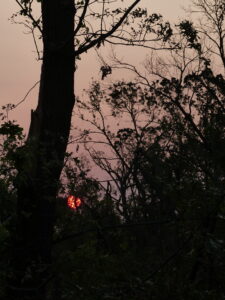
Smokes filters light.
Dr. Charles Goebel, Professor of Forest Ecosystem Restoration, explained, “Yes, smoke can impede photosynthesis. There is some research that indicates that short-term smoke exposure can reduce photosynthesis by as much as 50%. This is, in part, due to the reduced light intensity, destruction of chlorophyll, and reducing the flow of carbon dioxide through stomata.” He added that lower levels of smoke can help plants by increasing the carbon dioxide level and diffusing the light that some plants use better than direct sunlight.
How Plants React to Smoke
Dr. Goebel added fascinating aspects about plants and smoke. “Plants can filter out some smoke particles but probably not enough to make much difference during heavy smoke events. Smoke particles that settle to the ground may have some beneficial impact on plants. Smoke contains calcium, magnesium, and potassium, which are essential plant nutrients,” he added.
Wait…There Is More!
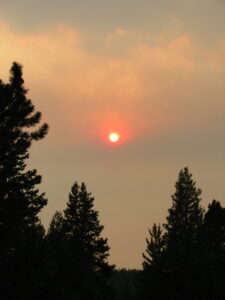
Wildfires are common in the West.
Dr. Lena N. Kobziar, Associate Professor of Wildland Fire Science, added: “We know that fires emit microbes (fungi, bacteria, archaea) along with other gaseous and particulate matter. Smoke transmits these living microbes that can colonize damaged soil and begin to grow and multiply. This can help the soil,” she said.
Want to learn more? Dr. Kobziar’s Fire Ecology Lab website has an enormous amount of current information on wildfires and their impact on forests and people.
The University of Idaho
We’re Vandals……meaning graduates of the University of Idaho. Our immediate family earned four degrees there. We’ve joke that the “real” U of I is not in Iowa City but in Moscow, Idaho. The Vandals are its mascot.
We enjoyed our academic careers at the U of I. Knowledge gained there helped our lives and careers and we humbly thank its faculty for continuing to answer our nature-related questions, like about smoke, years after graduation.
It’s a great institution. Take a look at the University of Idaho’s website. Go, Vandals!
by Winding Pathways | Jun 29, 2023 | Gazette Features, Travel/Columns, Wonderment
HOW?
Ancient people accomplished what seems impossible. How did they do it?
We recently toured the Earthmoving Legacy Center near Elkader, Iowa. On display were diesel and gasoline-powered machines able to move massive quantities of dirt for today’s needs. (Moving Heaven and Earth)
A month later we stood in a field near Chillicothe, Ohio, gazing at an enormous earth mound. The next day we visited other nearby sites with earthen walls, circles, and squares. All were separated by many miles and were large – some spanning hundreds of feet long and dozens of stories high. All were made around 2000 years ago by people of the Hopewell Culture. We learned that the squares are identical and fit inside the large circles. Somehow, they did this hard work without machines. No metal shovels. Not even wheelbarrows. How did they do it?
-
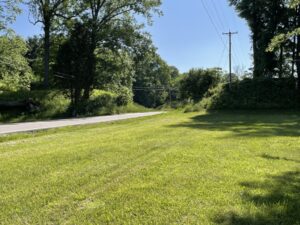
-
Modern intersecting with ancient.
-
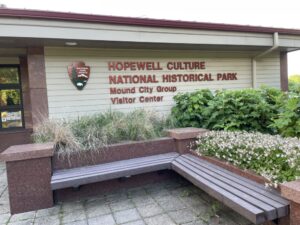
-
Headquarters.
Can a Principle of Geology Lend Insights?
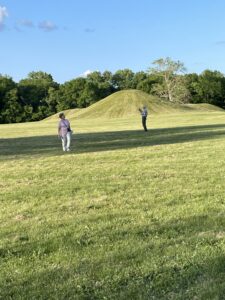
Recreated Earthworks
Hopewell, like visits to Effigy Mounds National Monument in Iowa and Cahokia in Illinois, stimulates more questions than answers. Perhaps a tenet of Geology can guide us. The Present is the Key to the Past. So, let’s consider. Why do we build structures? How do we move earth today? What do people who build need to sustain them while they build? (Food, shelter, clothing) Who provides this? Where do we get our goods? Perhaps these questions can provide insight into the past.
History is Written by the “Victors”
In our 1950s and 1960s school classes, we learned that European explorers and early settlers discovered scattered bands of Native Americans making a primitive living hunting, gathering, and gardening. No mention was made of our continent’s once vast population of sophisticated, technologically-advanced, and organized Native Americans who built magnificent structures and had an extensive trade system. Some of us did learn about the impressive Mayan and Aztec cultures in Mesoamerica.
Amazing Commerce
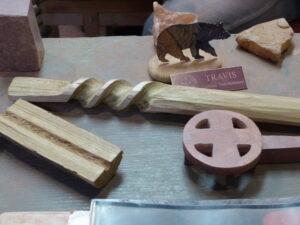
Pipestone was traded far and wide.
Little did we learn about the varied North American indigenous cultures that were far superior than originally believed. For example, Hopewell people made tools of obsidian that originated at Yellowstone, created jewelry of copper from the upper Great Lakes region, and used shells from the Gulf of Mexico. They somehow got these distantly sourced goods without airplanes, trucks, or Amazon Prime! Somehow goods moved across thousands of miles before horses and even wheels were available.
Sources of Information
Archeologists have solved some riddles about how ancient people did things, but many mysteries remain. Puzzling and fascinating. We have had published a number of pieces on ancients including the desert Southwest, to Pipestone in Minnesota, to Mounds along the Mississippi from Effigy to Cahokia.
Together, let us learn more about the rich heritage that is both before, beneath us, and behind us. A good source of information is The Great Courses offerings by Dr. Edwin Barnhart, Ancient Civilizations of North America, and Dr. Daniel Cobb, Native Peoples of North America.
by Winding Pathways | Jun 22, 2023 | (Sub)Urban Homesteading, Foraging, Mammals, Nature, Pests
Fish Camp Woes
This year a giant bear tore up the Popsie Fish Company’s camp near the remote Egegik River in Southwest Alaska before the salmon arrived. These huge brown bears are smart, hungry, and massively powerful.
Early Work on Salmon
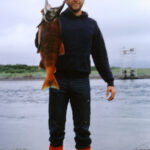
Good Catch
Early in his career, Rich was a salmon biologist for the Alaska Department of Fish and Game, working near the Egegik River. While there he loved eating the most delicious fish……. Sockeye Salmon.
During the summer millions of wild salmon of five species swarm into Bristol Bay but the sockeye is the most abundant. They are caught by many commercial fishing companies who net them in the bay and along beaches. State biologists ensure that enough fish survive nets to ascend rivers, spawn, and produce plenty of young to keep the runs robust.
Remembering Salmon Dinners

Fresh salmon is a treat.
Nearly a half-century ago he and Marion, co-owners of Winding Pathways, moved to the Midwest where there are no Sockeye Salmon. But they love grilling salmon fillets they order from the Popsie Fish Company. It catches, processes, and ships frozen fillets. The Pattersons occasionally order a box. In addition to being delicious and healthy, Alaskan Sockeye salmon are wild fish managed as a sustainable resource.
Bears on the Prowl
This year Popsie Owner Tony Neal had a problem. Like all commercial fishermen, he and his staff arrived well before the salmon run to set up their camp and prepare for fishing. That’s when the trouble arrived.
A brown bear tore its way into their building. Take a look at the photos to see what the bear did. It’s a mess.
-
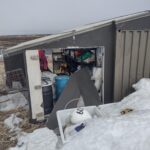
-
Bears are powerful. Photo Eric Handstad
-
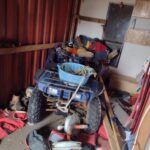
-
The work room is all shambles after a bear tore it up. Photo Eric Handstad
There is good news. There’s enough time before the salmon arrive to get everything fixed and ready to catch those delicious fish. To see Popsie Fish Company staff in action take a look at their website www.popsiefishco.com.
Increasing Occurrences of Bears
Iowans occasionally report a bear sighting, especially in NE Iowa where the woods make great shelter and rivers excellent corridors to travel.
Bears are increasing across the country even in urban areas. Past photos in papers have shown a bear walking down a major road near New York City. A recent newspaper article reported how a bear crashed into an Avon, CT, bakery and gobbled up 60 cupcakes before lumbering off. At Cedar Lake, Denville, NJ, a mama bear, and three cubs were recently spotted walking along the road. Actually, that is a fairly common sighting. Residents spread the word so walkers will be alert.
-
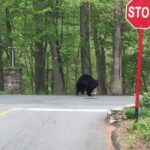
-
Suburban NJ has some prolific and big bears.
-
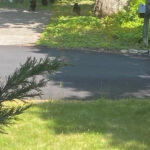
-
Bear and cubs. Photo Catherine Christ
The town police even fondly named one bruin “The Italian Bear.” Each night just after restaurants closed a fat bear would wander from its den, climb into the local Italian eatery’s dumpster, gorge itself, take a snooze, and come morning, climb out and go back to its secret den. Never hurt anyone.

SRF took this pix of a bear peering in the window.
In rural New Hampshire, friends have had bears visit the yard and peek into the house through the windows frequently.
First Person Story
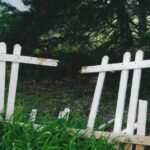
Picket fence was torn apart by a hungry spring-time bear.
Jackie and Peter Hull in Bedford, Virginia, shared this first-person story of the spring adventures with an unruly bear. “Well, I got up bright and early one spring morning, peeked out the bedroom window and what did I see? A smashed six-foot piece of picket fence, a broken spindle on the front porch, and a shepherd’s hook bent to the ground.
“Lucky me I brought the bird feeders in last night. So now I know I can’t feed the birds anymore this year. This is the second year running when on Mother’s Day last year, a bear came and smashed the spindles on the porch railing and a different six-foot piece of fence.
“Later we found bear tracks in the red Virginia clay bordering the flower bed on the outside of the fence. It left its muddy red prints on the fence and the steps going to the side door of the house!
“What to do but repair the fence again, wash the feeders, and put them in the basement? I have decided to store the leftover bird feed in a large bag in the freezer for next winter.
“I will miss my “bird buddies” but I don’t what a 250+ pound bear in my house either. So, words to the wise, the same ones the ranger gave me last year, ‘Bring your feeders in now.'”
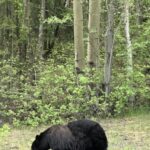
Alaskan Bear.
Back in Alaska, it is common even in suburban Anchorage neighborhoods to see a bear lumbering down a road. An Alaska-born, former Gazette editor spoke nonchalantly about bears and recess at schools. “We always had outdoor recess…except when a bear roamed the playground.”
Bears are about that is for sure!
by Winding Pathways | Jun 15, 2023 | Nature, Reflections/Profiles, Wonderment
Sitting: it’s a rewarding outdoor activity. How can that be when everyone knows that being outdoors means movement? Hiking, cycling, skiing, canoeing, and swimming all get the heart beating and muscles working.
-
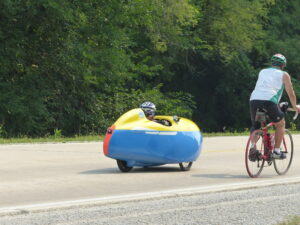
-
You see everything on RAGBRAI
-
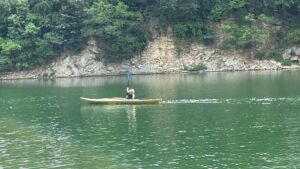
-
Kayaking gets the heart pumping and strengthens the arms
We love all these activities but recently were reminded that sitting quietly is a fascinating and productive way to spend time outdoors. On a gorgeous May morning, we stopped at the road’s end in Iowa’s Brush Creek Canyon Nature Preserve. A narrow informal path lured us past a rock outcropping high above a gurgling brook.
We carried the sling chairs and binoculars that we keep in the car down a narrow informal footpath. Just a hundred yards later we found a level spot with a perfect view downward through trees to the water.
Sit we did. Enmeshed in secluded quiet we sat so still that warblers and vireos flitted among the trees. Even a hummingbird buzzed in front of us. A fly settled on Rich’s pants, explored a bit, and then went on its way.
Active outdoor activities are good for the body and mind, but sometimes sitting is the best way to notice our world and its inhabitants. When we scurry down a trail, wildlife hides or flees. When we sit and become part of the landscape, wildlife ignores the human presence and goes about its business.
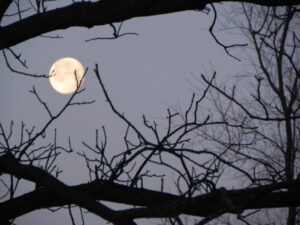
Tree branches help you watch the moon move across the sky.
Here’s our favorite sitting exercise that can be done almost anywhere. As a full moon rises, position a comfortable chair with tree branches or even overhead wires between it and the moon. Sit very still. Using branches or the wire as a reference it’s possible to watch the moon move.
Oh, Brush Creek Canyon. We recommend it as one of Iowa’s wildest natural gems. It’s just north of Arlington in Fayette County. Go outside. Have fun.
-
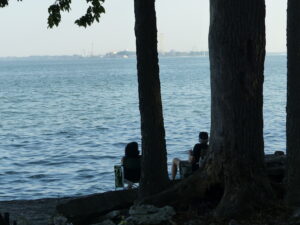
-
Couple by lake
-
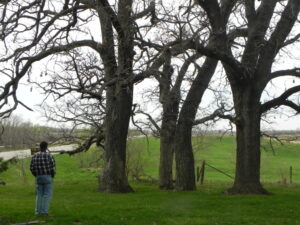
-
Wonderment
-
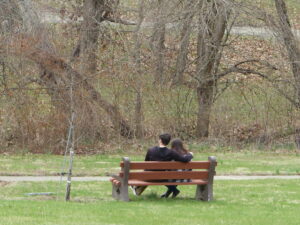
-
Finding peace
























